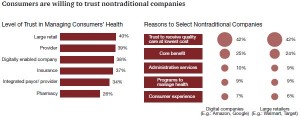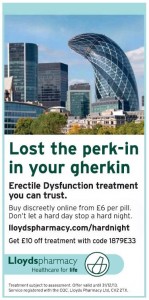 40% of U.S. consumers trust Big Retail to manage their health; 39% of U.S. consumers trust healthcare providers to manage their health.
40% of U.S. consumers trust Big Retail to manage their health; 39% of U.S. consumers trust healthcare providers to manage their health.
What’s wrong with this picture? The first chart shows the neck-and-neck tie in the horse race for consumer trust in personal health management. The Walmart primary care clinic vs. your doctor. The grocery pharmacy vis-a-vis the hospital or chain pharmacy. Costco compared to the chiropractor. Or Apple, Google, Microsoft, Samsung or UnderArmour, because “digitally-enabled companies” are virtually tied with health providers and large retailers as responsible health care managers.
Welcome to The Birth of the Healthcare Consumer according to Strategy&, the consultancy. Their report sports the descriptive tagline, “growing demands for choice, engagement and experience.”
This portrait of the consumer placing trust in new entrants to the healthcare ecosystem has a unifying message behind it: trust in receiving qualitiy care at lower cost. Cost is a driver for mainstream healthcare consumers, this survey discovered.
Consumers’ growing cost-sensitivity in healthcare was echoed in the recent survey by McKinsey on consumers’ shopping behaviors on the health insurance marketplaces which found several buyers’ segments strongly driven by the price of health plans.
Health Populi’s Hot Points: In addition to price, trust and authenticity are key precursors to consumer health engagement. The latest Harris Poll RQ on consumers’ opinions of company reputations was published in February 2015 and found Wegmans, Amazon, Samsung, Costco, and Johnson & Johnson ranked first through fifth in the general public’s opinion.
Looking at the second graph, you’ll find that consumers rank most highly technology companies, followed by travel, consumer products, and retail. Then come manufacturing and telecomm, automotive and energy.
In the fourth tier, consumers lump pharmaceutical, insurance, airlines and financial services.
At rock bottom? Tobacco and government.
So what’s wrong with that first picture, painting in the second picture?
In this growing era of consumer-driven health care — where consumers are emerging as a major payor, in parallel with health plans, employers, and health systems — there is absolutely nothing wrong with that first picture. It illustrates peoples’ honest feelings about retail transactions in their real lives, when faced with coupons and discounts, customer service and transparency of prices, Uber and Amazon and TripAdvisor, et. al.
Peoples’ health ecosystems aren’t a world of this ‘or’ that, in vs. out. People will look to the players the health/care ecosystem to break down siloes, make their data liquid at the point-of-where-they-want-it (which means if the point-of-care is home, that’s where their data must go).
 This is the new retail health.
This is the new retail health.
Imagine riding in a London tax cab 2 weeks ago and seeing this ad in the back enroute to a business meeting in The City – asking if you’ve, “lost the perk-in in your gherkin.”
The Gherkin is the 180 meters-tall architectural tower at 30 Mary Axe Street in the financial center of London, built in 2004 and designed by the great designers at Foster & Partners.
In this ad, an architect has “wilted” the tower, and Lloydspharmacy is using it to market erectile dysfunction treatment. The ad speaks in real-life language, includes a coupon, and offers the treatment online.
Large retail, indeed.





 Interviewed live on BNN Bloomberg (Canada) on the market for GLP-1 drugs for weight loss and their impact on both the health care system and consumer goods and services -- notably, food, nutrition, retail health, gyms, and other sectors.
Interviewed live on BNN Bloomberg (Canada) on the market for GLP-1 drugs for weight loss and their impact on both the health care system and consumer goods and services -- notably, food, nutrition, retail health, gyms, and other sectors. Thank you, Feedspot, for
Thank you, Feedspot, for  As you may know, I have been splitting work- and living-time between the U.S. and the E.U., most recently living in and working from Brussels. In the month of September 2024, I'll be splitting time between London and other parts of the U.K., and Italy where I'll be working with clients on consumer health, self-care and home care focused on food-as-medicine, digital health, business and scenario planning for the future...
As you may know, I have been splitting work- and living-time between the U.S. and the E.U., most recently living in and working from Brussels. In the month of September 2024, I'll be splitting time between London and other parts of the U.K., and Italy where I'll be working with clients on consumer health, self-care and home care focused on food-as-medicine, digital health, business and scenario planning for the future...